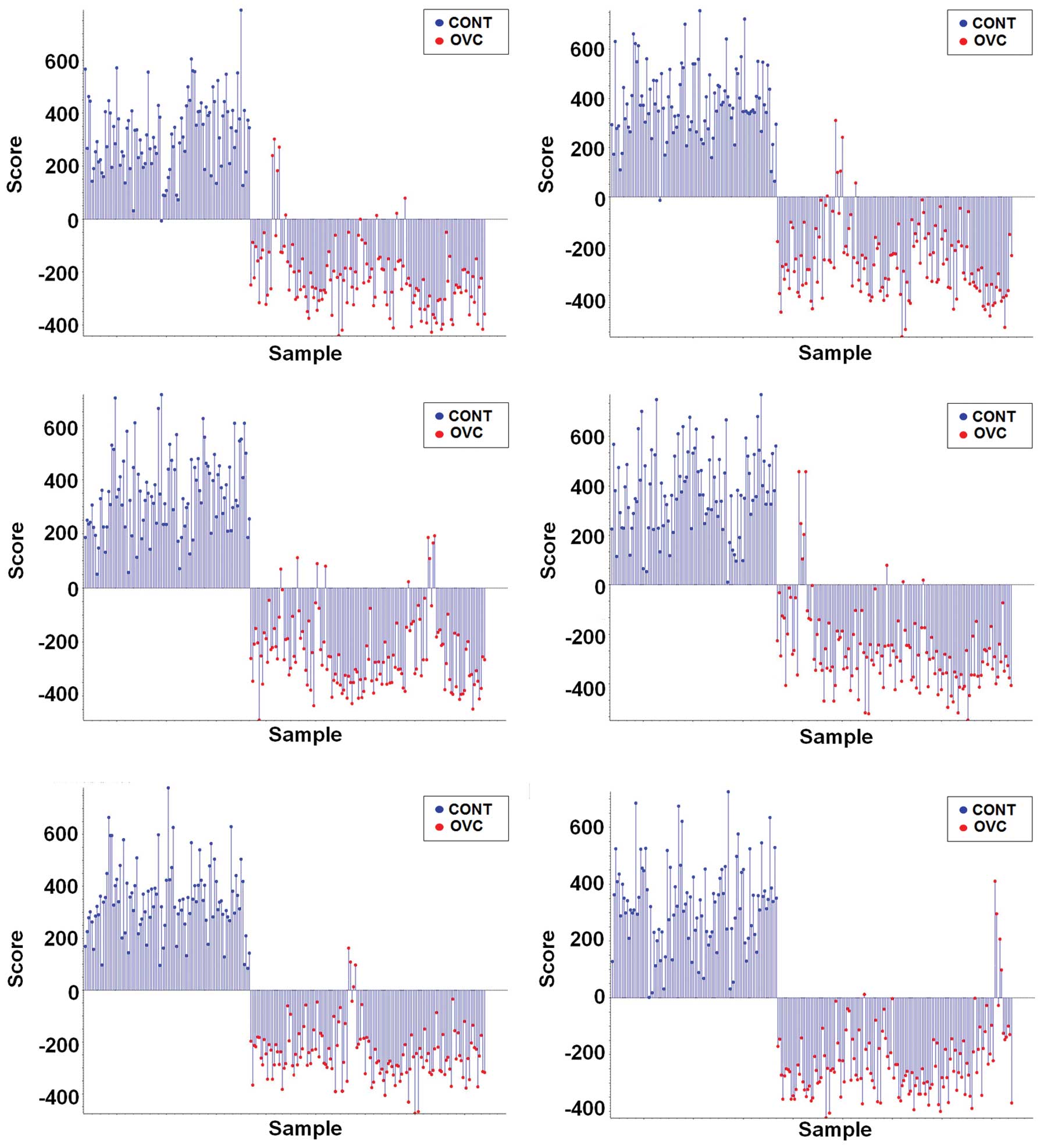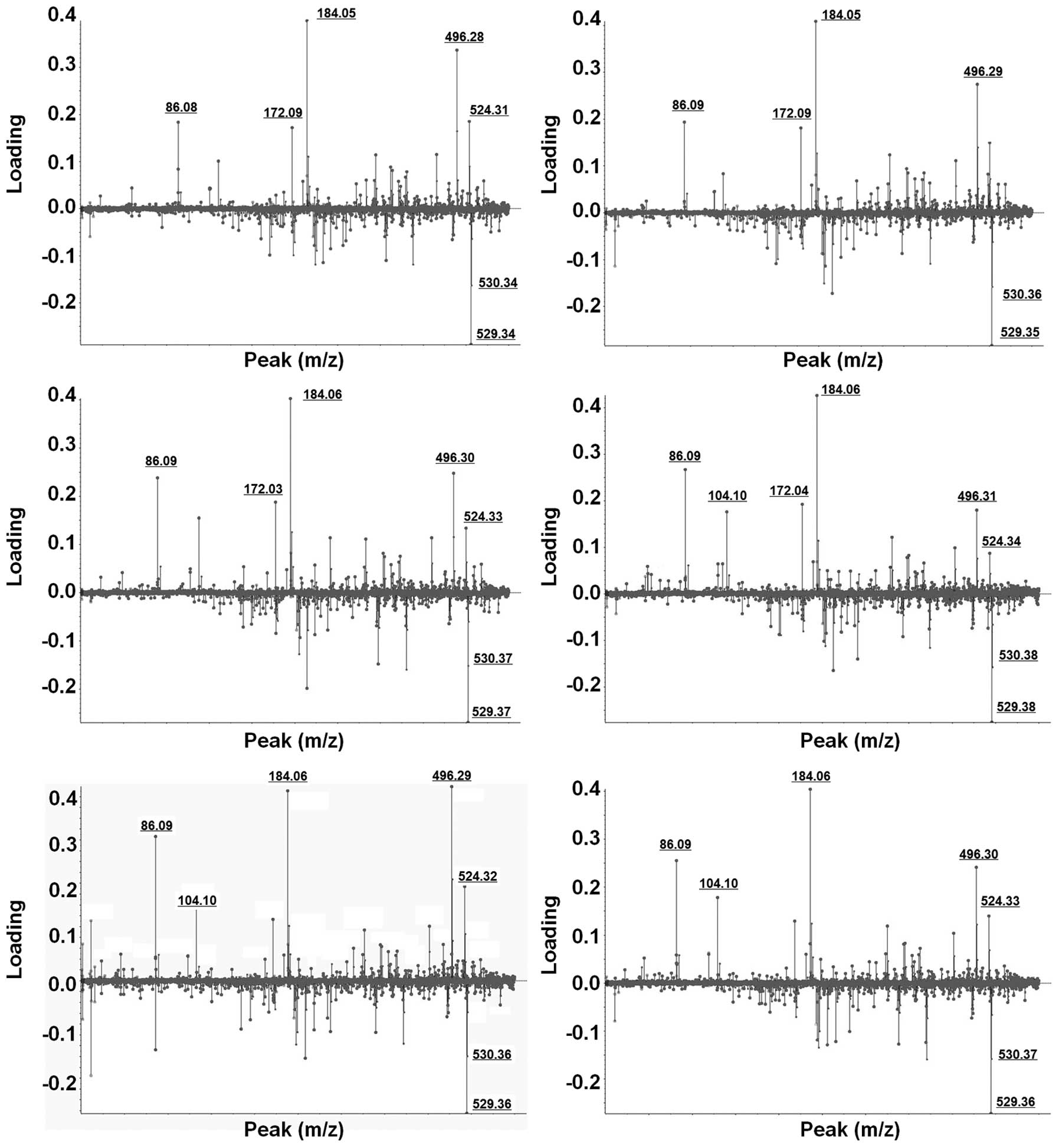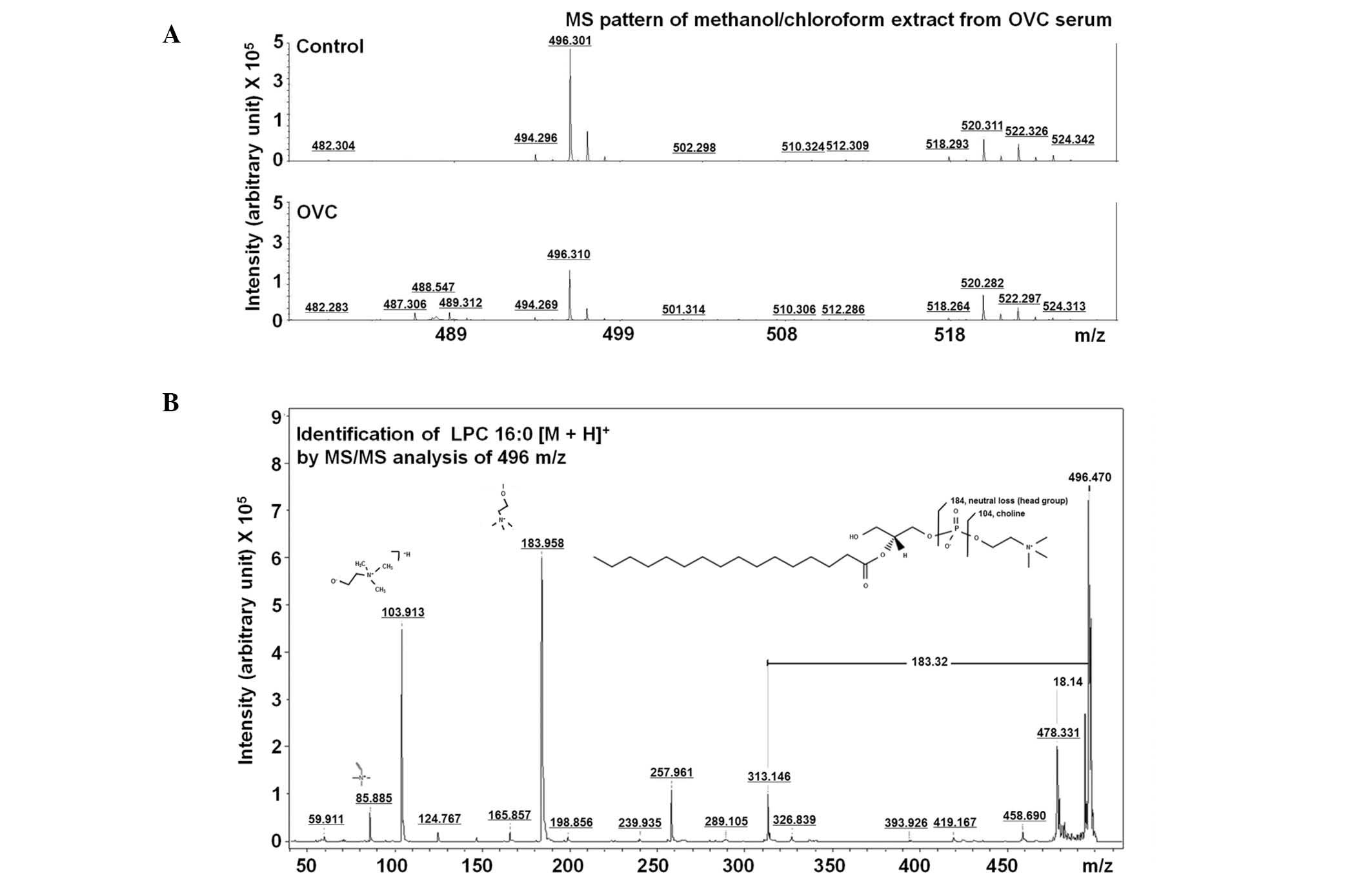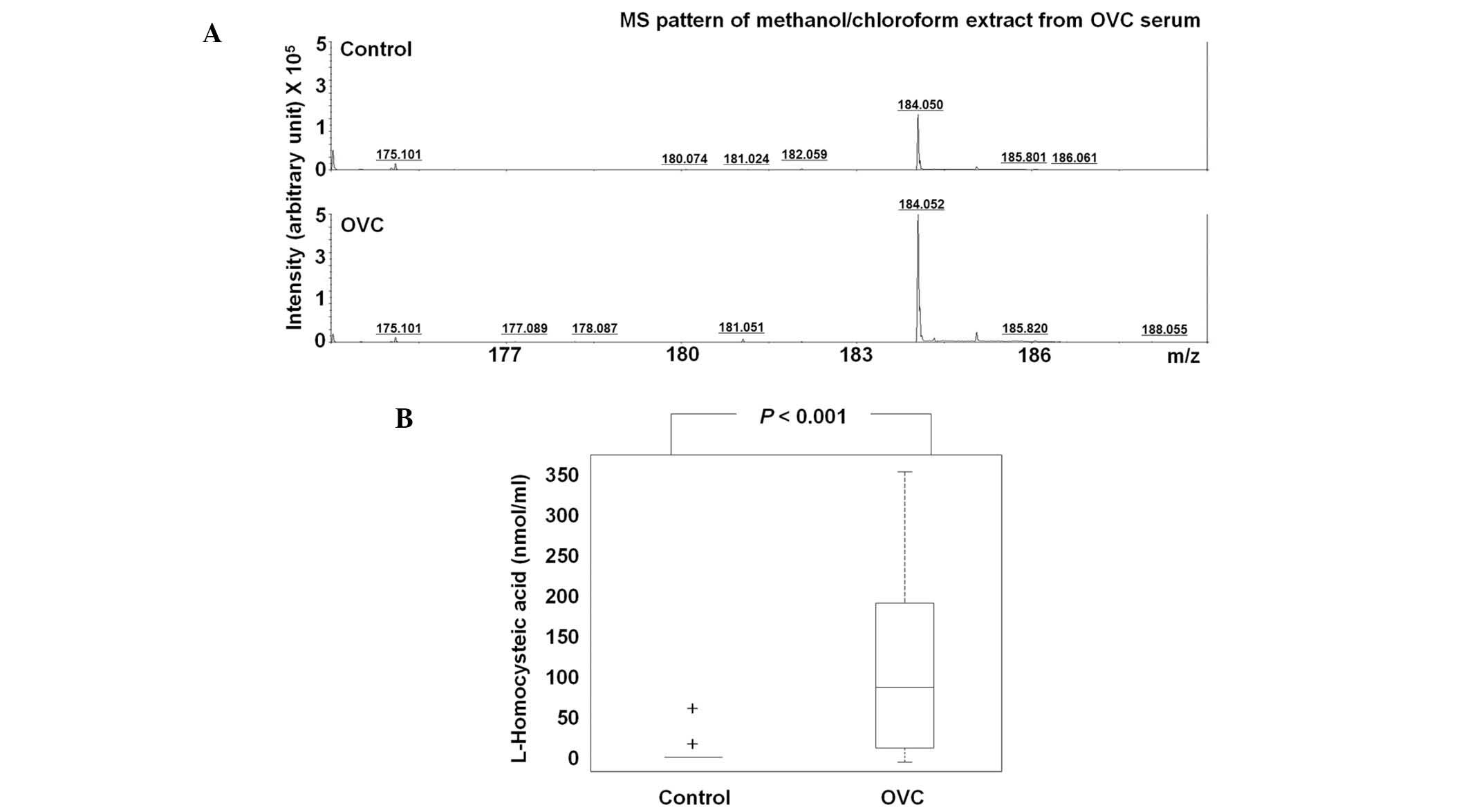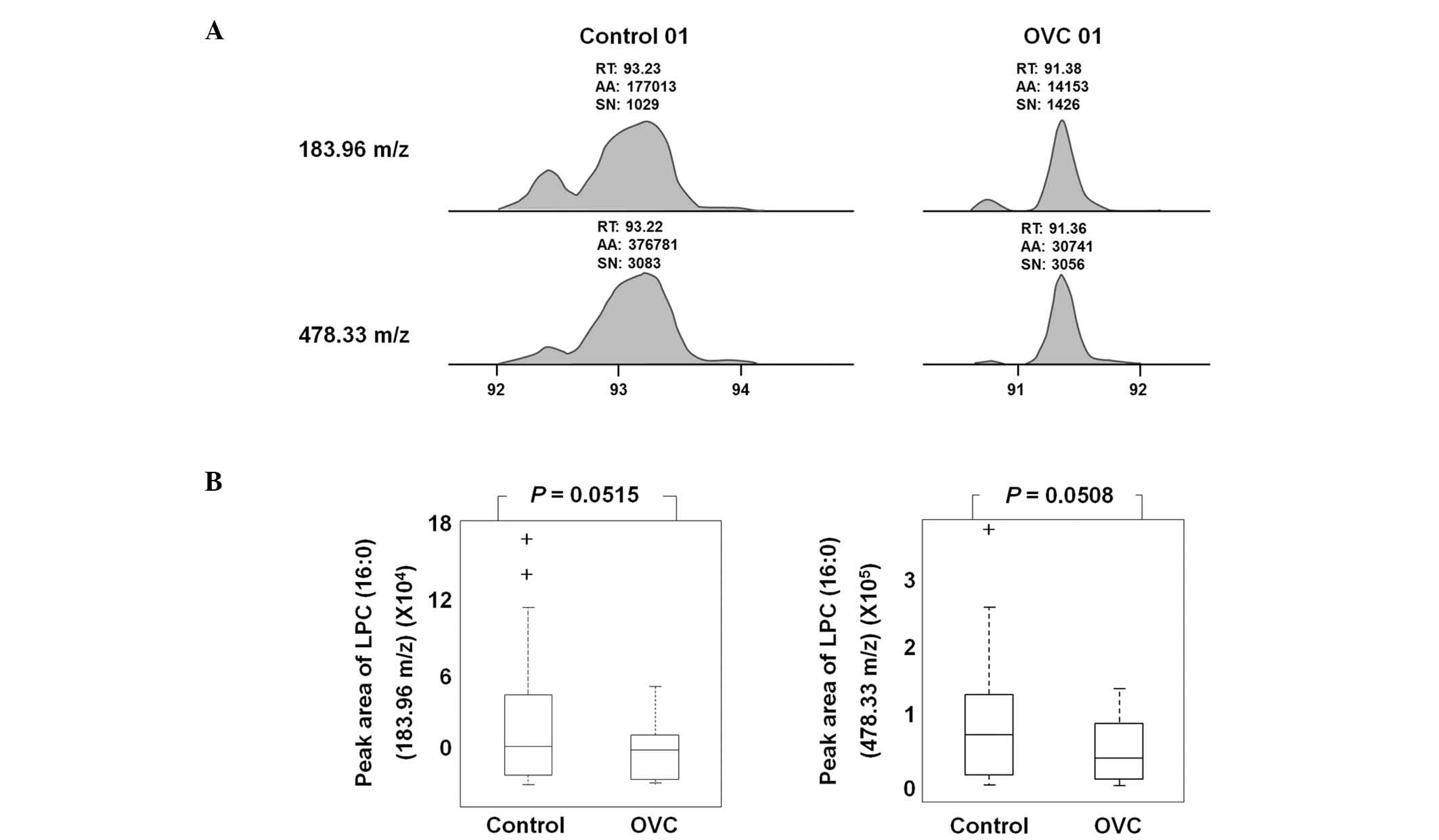Differential levels of L‑homocysteic acid and lysophosphatidylcholine (16:0) in sera of patients with ovarian cancer
- Authors:
- Published online on: June 3, 2014 https://doi.org/10.3892/ol.2014.2214
- Pages: 566-574
Abstract
Introduction
Ovarian cancer (OVC) is one of the most frequently occurring types of gynecological cancer, with 204,000 new cases identified each year and a five-year survival rate of 44% for all stages of cancer development (1–4). More than 70% of OVC cases are identified in the late stages of cancer (stage III or IV according to the International Federation of Gynecology and Obstetrics standard) (2). Despite improvements in anticancer therapeutic methods, the mortality rate of OVC has not decreased over the past 20 years due to difficulties in screening early stages of the disease (5). Current diagnostic methods include pelvic examination, ultrasonograms, blood tests and tissue examination (6,7); however, these methods have several limitations, including their inability to diagnose OVC at an early stage or to detect invasiveness. Thus, early and easy-to-use diagnostic methods for OVC are required in order to increase the survival rate of patients with OVC.
Several previous studies have investigated the use of serological markers to accurately detect OVC. Such markers include cancer antigen (CA) 125, human epididymis protein 4 (HE4), and macrophage colony-stimulating factor (M-CSF) (5,8,10). Serum CA125 and HE4 concentrations have been used as markers for OVC using radioimmunoassay (6,9,10). Furthermore, 70% of patients with OVC with various OVC cell lines have high serum levels of M-CSF (11). While M-CSF is a monocyte-specific cytokine for proliferation and differentiation, it also acts as a growth factor for certain epithelial cancers in an autocrine and paracrine manner (12). However, these markers lack accuracy and have difficulty in early diagnosis. For example CA125 was discovered 20 years ago and has been used widely as an OVC marker since (13). However, CA125 has low specificity and sensitivity during the early stages of OVC (6,9,14), thus an ideal marker has yet to be elucidated.
The present study profiled low-mass metabolic compounds in methanol/chloroform extracts obtained from the sera of patients with OVC and healthy controls using matrix-assisted laser desorption/ionization-time-of-flight (MALDI-TOF) mass spectrometry and identified two molecules using tandem mass spectrometry (MS/MS) analysis. The present study identified a differential pattern of lysophosphatidylcholine (LPC) (16:0) and L-homocysteic acid (HCA) in patients with OVC, and discusses the advantages of profiling low-mass metabolic compounds for screening OVC.
Materials and methods
Serum from patients with OVC
All participants provided written informed consent and the study protocol was approved by the Institutional Review Board of the Ewha Womans University (Seoul, Korea). A total of 142 patients and 100 control participants were enrolled in the present study (Table I).
Table ICharacteristics of the patients with ovarian cancer and the control participants included in the present study. |
MALDI-TOF analysis for collecting low-mass ions (LMIs) in serum
Four times volume of methanol/chloroform (2:1; v/v) was incubated with 25 μl serum for 10 min at room temperature subsequent to vortexing. The solution was centrifuged at 6,000 × g for 10 min at 4°C. The supernatant was then dried in a concentrator for 1 h and resolved in 30 μl 50% acetonitrile/0.1% trifluoroacetic acid (TFA) using a vortex for 30 min.
Methanol/chloroform extract was mixed (1:12; v/v) with an α-cyano-4-hydroxycinnamic acid solution in 50% acetonitrile/0.1% TFA. A total of 1 μl of the solution was then spotted on the MALDI target for analysis. Individual mass spectra from the serum extracts of the patients with OVC were obtained using a 4700 Proteomics Analyzer (Ab Sciex, Framingham, MA, USA). The mass-spectral data represent the average of 20 accumulated spectra. All individual peak areas were normalized to the total area up to 2,500 m/z. To minimize experimental error, variable factors including focus mass, laser intensity, target plate and data acquisition time were tested. The ideal focus mass and laser intensity were fixed at 500 m/z and 5,000, respectively (15). With the fixed focus mass and laser intensity, one sample was analyzed six times under the different extraction and data acquisition times.
LMI selection and statistical analysis
All MALDI mass spectra, formatted as t2d files, were analyzed using MarkerView™ software, version 1.2 (Applied Biosystems/MDS Sciex, Toronto, ON, Canada). The optimized parameters used to compare LMI mass peaks in the serum extracts obtained from the patients with OVC were as follows: Mass tolerance, 100 ppm; minimum required response, 100; maximum number of peaks, 5000; and normalization, by total area sums. Subsequent to collecting the data using MALDI mass spectra, principal component analysis-discriminant analysis (PCA-DA) and t-tests were used to select LMIs with differential peak intensities in serum extracts from patients with OVC.
Measurement of HCA in serum
The level of HCA in the sera was measured using an ELISA kit (Cusabio Biotech, Co., Ltd., Wuhan, China) according to the manufacturer’s instructions.
Measurement of LPC (16:0) in serum
A nanoflow high-performance liquid chromatography instrument (Easy nLC; Thermo Scientific, Inc., Waltham, MA, USA) was coupled to an LTQ mass spectrometer (Thermo Scientific, Inc.). A PepMap® RSLC, C18, 2 μm, 100 Å analytical column (50 cm; inner diameter, 75 μm; Dianex Corporation, Sunnyvale, CA, USA) was used. Reversed phase chromatography was performed using a binary buffer system consisting of 0.1% formic acid (buffer A) and acetonitrile in 0.1% formic acid (buffer B). The sample was separated using a linear gradient of 3–50% buffer B at a flow rate of 300 nl/min. The gradient time was 90 min and the total run time for the liquid chromatography MS/MS was 120 min. The extracted LPC was analyzed using the selected reaction monitoring (SRM) mode. The SRM transitions for the LPC lipid were set to m/z 496.4 to 183.96 and m/z 496.4 to 478.33. The SRM data were acquired within fragment ion mass ± 2 m/z and each SRM transition and respective retention time was validated for specific LPC. Data were processed through integrating the appropriate peaks for LPC, followed by comparing the calculated peak areas using two-paired t-tests.
Statistical analysis
Between-group differences were calculated using the student’s t-test and within-group correlations were calculated using Spearman’s rank correlation coefficient. P<0.05 was considered to indicate a statistically significant difference.
Results
Differential LMIs in methanol/chloroform extracts from the sera of patients with OVC
Data (m/z and mass peak intensity) regarding the LMIs with mostly <1,000 m/z collected from the sera extracts of 100 healthy control individuals and 142 patients with OVC were used in the PCA-DA in order to determine whether differential LMI patterns exist in the sera of patients with OVC. Supervised PCA-DA using LMI data obtained from six repeats of MALDI-TOF analysis discriminated the patients with OVC from the control individuals (Fig. 1).
Selection and identification of LMIs showing a differential pattern in patients with OVC
Weighting factors (loading value) for all individual LMIs were calculated using PCA-DA (Fig. 2). LMIs which consistently exhibited higher weighting factors in six different PCA-DA analyses were selected. Despite slight mass shifting, LMIs with 184.05 and 496.30 m/z showed strong discriminating power for OVC screening (Fig. 2).
In order to identify LMIs with 184.05 and 496.30 m/z, candidate metabolites within ± 0.05 m/z difference were identified using the Human Metabolome Database (HMDB). Ten candidate metabolites with 184.05±0.05 m/z were identified (Table II). Among the candidate metabolites, the metabolic description of HCA in the HMDB was most correlated with OVC, and LPC (16:0) was the only metabolite with 496.30±0.05 m/z (Table II). The LMI with 496.30 m/z on the mass spectrum (Fig. 3A) was further analyzed using MS/MS analysis and was identified to be LPC (16:0) through comparing the MS/MS spectrum of lipid compounds (Fig. 3B).
Differential level of HCA and LPC (16:0)
The level of HCA was assessed in 63 control participants and 25 patients with OVC (Table III). Due to insufficient amounts of sera, HCA was not detected in 59/63 of the controls, but the majority of cases of OVC (16/25) exhibited significantly higher levels of HCA, with the mean HCA concentration in the sera of the control individuals being 0.16 nmol/ml compared with 0.60 nmol/ml in the patients with OVC (P<0.001; Fig. 4A). At the cutoff of 10 nmol/ml, the sensitivity and specificity of HCA were 64.0 and 96.9%, respectively; thus, HCA may have potential for OVC screening (Table III).
LPC (16:0) was detected as an LMI with either 183.96 or 478.33 m/z in LC-MS/MS analysis (Fig. 5A). A sufficient amount of sera was obtained from 19 control individuals and 20 patients with OVC to quantify the level of LPC (16:0) and peak areas of 183.96 and 478.33 m/z were determined (Table IV). The peak area was variable depending on the individual samples, but the level of LPC (16:0), represented by peak areas of 183.96 and 478.33 m/z, was observed to be lower in the sera of patients with OVC compared with that of the controls (P=0.0515 and 0.0508, respectively; Fig. 5B).
Clinicopathological relevance of LPC (16:0) and HCA in OVC
Increased LPC (16:0) was found to be significantly correlated with tumor grade (P=0.045). Although not statistically significant, possibly due to the small number of samples, HCA and LPC (16:0) were found to be correlated with stage and tumor histology (data not shown).
Discussion
Despite previous investigations, a diagnostic marker for the early diagnosis of OVC has yet to be elucidated. Previous markers which have been used for OVC, including CA125 and HE4, only detected OVC at the late stages of cancer development and lacked efficiency during early tumor growth (13,14).
Metabolic compounds are detected as LMIs in mass spectrometry. Our previous study showed an example of LMI profiling for cancer screening (15). However, at present, the dynamic status of metabolic compounds in the blood is poorly understood. Metabolic compounds in the blood are capable of showing disease status; therefore, profiling LMIs may be useful not only for understanding cancer, but also for identifying biomarkers. Furthermore, recent mass technology, including MALDI-TOF and liquid chromatography-MS/MS, has been found to provide extremely precise and accurate data on LMIs. Therefore, the present study aimed to profile LMIs in serum extracts to assess whether such profiling is capable of discriminate OVC. PCA-DA results showed that the profile of LMIs discriminated OVC (Fig. 1). Only one control case was assigned as OVC over the six experimental repeats (Fig. 1), allowing the LMIs with a significant effect of discriminating OVC to be selected (Fig. 2). Two metabolic compounds were identified and quantified: HCA and LPC (16:0) (Figs. 3–5).
HCA has been reported to affect the oxidation of homocysteinethiolactone to sulfated glycosaminoglycans in cartilage (16). The free base of homocysteinethiolactone has been found to induce carcinogenesis in a mouse model, thus abnormal homocysteine metabolism may be associated with carcinogenesis (16). Dysregulated levels of HCA have not been reported in cancers, although markedly increased HCA has been detected in the cerebrospinal fluid of patients with lymphoma treated with methtrexate (17,18). In the present study, the profiling of LMIs revealed that the level of HCA was different in the serum of patients with OVC compared with healthy control individuals, which was shown through the quantification of HCA in the sera of the controls and the patients with OVC (Fig. 4 and Table III). HCA was not detected in the majority of the control participants, but many of the patients with OVC (16/25) showed significantly higher HCA levels (Table III). At the cutoff of 10 nmol/ml, the sensitivity and specificity of HCA were 64.0 and 96.9%, respectively. The biological implications of upregulated HCA in the sera of patients with OVC has yet to be elucidated and the level of HCA in other types of cancer has yet to be reported. However, the present study found that HCA has strong potential for OVC screening.
The level of LPC in the blood of patients with cancer varies depending on the type of cancer, with LPC found to be decreased in breast cancer (19) and increased in hepatocellular carcinoma (20). In the present study, LPC (16:0) was observed to be decreased in the serum of patients with OVC (Fig. 5). LPC acts as a bioactive mediator in wound healing and inflammation (21), but also has a role in the progression of OVC (22) and lung cancer (23). LPC has many subtypes, and each subtype has a different length of carbon chain. Although the role of each LPC subtype has yet to be elucidated, in the present study, LPC (16:0) was found to be correlated with tumor grade in patients with OVC (P=0.045).
In conclusion, the present study demonstrated that LMI profiling may be a powerful tool to obtain valuable data on metabolic compounds, as well as to identify biomarkers for cancer screening. Despite the lack of explanation for the pathological changes in HCA and LPC (16:0) in the sera of patients with OVC, the findings of the present study demonstrate that HCA is a powerful serological biomarker for OVC screening. In the present study, LPC alone was not helpful to increase the discriminating power of HCA; however, with the identification of other candidate metabolites in the future, HCA has the potential to be used in multi-biomarker OVC screening.
Acknowledgements
The present study was supported by a grant from the Korean Health Technology R&D Project (Ministry of Health and Welfare, Korea; grant no. HI12C0050) and the Ewha Global Top 5 Grant 2011 of Ewha Womans University.



